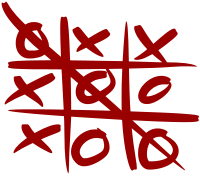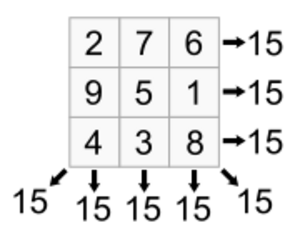Tic-tac-toe facts for kids

A completed game of tic-tac-toe
|
|
| Genre(s) | Paper-and-pencil game |
|---|---|
| Players | 2 |
| Setup time | Minimal |
| Playing time | ~1 minute |
| Random chance | None |
| Skill(s) required | Strategy, tactics, observation |
| Synonym(s) | Noughts and crosses Xs and Os |
Tic-tac-toe is a classic paper-and-pencil game for two players. It's known by different names around the world, like noughts and crosses in the UK and Australia, or Xs and Os in Ireland. In this game, two players, one using 'X' and the other 'O', take turns marking spaces on a 3x3 grid. The goal is to be the first player to get three of your marks in a row. This can be a horizontal (across), vertical (up and down), or diagonal (corner to corner) line. If both players play perfectly, the game always ends in a draw.
Contents
How to Play Tic-Tac-Toe
To win Tic-tac-toe, a player needs to place three of their marks in a straight line. This line can go across, up and down, or diagonally.
Here's an example game where player X wins:
Most players quickly learn that if both people play their best, the game usually ends in a tie. Because of this, Tic-tac-toe is often played by younger children who are still learning the best ways to play.
This simple game is also used to teach important ideas. For example, it helps teach about good sportsmanship. It's also used in artificial intelligence to show how computers can "think" through all possible moves in a game. It's quite easy to write a computer program that can play Tic-tac-toe perfectly.
Game Outcomes
When we look at all the possible ways a Tic-tac-toe board can end, there are 138 unique final positions if we count rotations and reflections as the same.
If player "X" always goes first, here's what usually happens:
- 91 different ways for X to win.
- 44 different ways for O to win.
- 3 different ways for the game to end in a draw (a "cat's game").
Winning Strategies
A player can play a perfect game of Tic-tac-toe, meaning they will either win or at least get a draw. To do this, they should always choose the first available move from this list:
- Win: If you have two of your marks in a row, place your third mark to complete the line and win.
- Block: If your opponent has two of their marks in a row, you must place your mark to stop them from winning.
- Fork: Create a situation where you have two different ways to win on your next turn. This puts your opponent in a tough spot.
- Block Opponent's Fork: If your opponent can create a fork, you need to stop it. If there's only one way for them to make a fork, block it. If there are multiple ways, block them in a way that also helps you create two marks in a row.
- Center: Place your mark in the middle square. This is often a good move.
- Opposite Corner: If your opponent plays in a corner, place your mark in the corner directly opposite theirs.
- Empty Corner: If no other moves on this list apply, play in any empty corner square.
- Empty Side: If no other moves apply, play in any empty middle square on one of the four sides.
The first player, "X", has three main starting moves that are different from a strategy point of view: a corner, a side (edge), or the center. Player X can win or force a draw from any of these starts. However, starting in a corner gives the second player, "O", fewer good choices, which might make them make a mistake.
The second player, "O", must respond carefully to X's first move to avoid losing.
- If X starts in a corner, O should always play in the center.
- If X starts in the center, O should always play in a corner.
- If X starts on a side, O should play in the center, a corner next to X, or the side opposite X.
After the first moves, both players should follow the list of priorities above to try and win, or at least get a draw.
Here are some more tips for player O to guarantee a draw:
- If X starts in a corner, O should take the center. Then, O should play on a side. This helps stop X from creating forks.
- If X starts on a side, O should take the center or a corner next to X. Then, O should follow the priority list, focusing on blocking forks.
- If X starts in the center, O should take a corner. Then, O should follow the priority list, focusing on blocking forks.
If X starts in a corner and O doesn't play perfectly, X might win:
- If O plays a corner as their second move (after X starts in a corner and O takes the center), X can take the last empty corner. This blocks O and creates a fork for X to win.
- If O plays on a side as their first move, X can win by taking the center. Then O can only take the corner opposite X's first move. Finally, X can take another corner to create a fork and win.
Different Ways to Play
Many games are like Tic-tac-toe because they involve trying to get a certain number of your pieces in a row. Some examples include Connect Four and Gomoku. Tic-tac-toe is a simple version of a bigger group of games called "m,n,k-games," where players try to get 'k' in a row on an 'm' by 'n' board.
Other fun versions of Tic-tac-toe include:
- 3D Tic-tac-toe: This is played on a 3x3x3 board (like a cube). The first player can often win easily by playing in the very center of the cube.
- 4x4 Board: Some versions use a bigger 4x4 board. To win, you might need four in a straight line, four in a diamond shape, or four to make a square.
- Qubic: This is played on a 4x4x4 board. It's been figured out that the first player can always win this game.
- Wild Tic-tac-toe: In this version, players can choose to place either an 'X' or an 'O' on the board during their turn.
- Number Scrabble (Pick15): This game seems very different but is actually the same as Tic-tac-toe! Two players take turns saying a number between one and nine. You can only use each number once. The first player to pick three numbers that add up to 15 wins. If you put these numbers on a magic square (where all rows, columns, and diagonals add up to 15), you'll see it's exactly like Tic-tac-toe.
- Numerical Tic Tac Toe: Invented by mathematician Ronald Graham, this game uses numbers 1 to 9. The first player uses odd numbers, and the second player uses even numbers. Each number can only be used once. The player who places three numbers in a line that add up to 15 wins.
- Quantum Tic Tac Toe: This is a more complex version where players can place "superpositions" of moves, meaning a move can be in more than one spot at the same time until the game progresses.
Different Names for the Game
This game has many names depending on where you are in the world:
- Tick-tack-toe or Tic-tac-toe (United States, Canada)
- Noughts and crosses (United Kingdom, Republic of Ireland, Australia, New Zealand, South Africa, Zimbabwe, India)
- Exy-ozies (Northern Ireland, usually spoken)
- Xs and Os (Ireland, Zimbabwe, Canada, Israel, Scotland)
Sometimes, people confuse Tic-tac-toe with three men's morris. In Tic-tac-toe, players keep adding marks to the board. In three men's morris, players place a few pieces and then start moving them around the board.
Tic-Tac-Toe in Pop Culture
Tic-tac-toe has appeared in many places, including songs and TV shows.
- A song called "Tit, Tac, Toe" was written by George Cooper and John Rogers Thomas in 1876.
- Arcade games in the 1970s even featured chickens that could play Tic-tac-toe! The chickens were trained to peck the right spots, which were chosen by a computer.
Several TV game shows have been based on Tic-tac-toe:
- On Hollywood Squares, nine celebrities sat in a giant Tic-tac-toe grid. Players would win squares by agreeing or disagreeing with a celebrity's answer to a question.
- In Tic-Tac-Dough, players answered questions to earn their 'X' or 'O' on the board.
- On The Price Is Right, there's a game called "Secret X." Players guess prices to win 'X's and try to make a Tic-tac-toe line with a hidden 'X' on the board.
- The show Minute to Win It had a challenge called "Ping Tac Toe." A contestant had to bounce ping-pong balls into nine glasses to get three in a row, using two different colors of balls.
See also
 In Spanish: Tres en línea para niños
In Spanish: Tres en línea para niños




